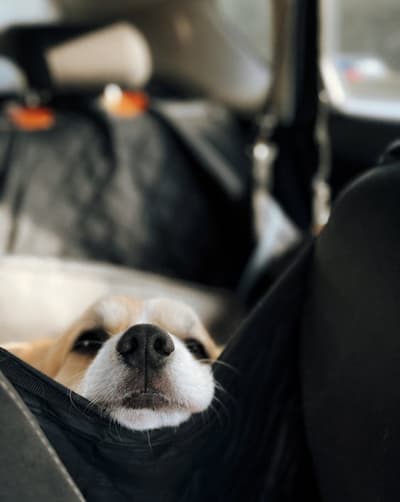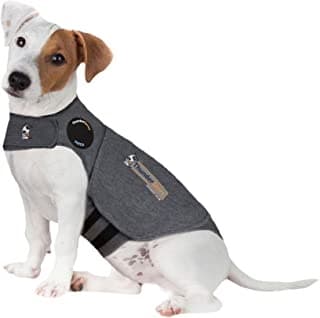Moving With Your Dog
Follow A Plan To Cut The Stress!
Moving with your dog can feel like a big adventure — for both of you. While you might be excited about the change, your furry friend may be unsure about all the boxes, new smells, and sudden changes. The good news? With a little preparation, you can make the experience calmer, safer, and even enjoyable for your four-legged companion.

Below are practical tips to help reduce your dog’s anxiety and make your move feel like a shared adventure rather than a whirlwind.
Preparing Your Dog for a Move
When you’re moving with your dog, try to see the process from his perspective. The sooner you start preparing, the easier it will be.
A moving timeline can help:
- 4 weeks before: Begin exposing your dog to packing materials and moving boxes. Let him sniff and explore them at his own pace.
- 3 weeks before: Keep his routine as normal as possible while gradually introducing more “moving day” sights and sounds.
- 1–2 weeks before: If he’s not used to a crate or seat belt harness, start short practice sessions in the car.
Imagine how unsettling it would be to wake up and see all your belongings being hauled out the door with no warning. Gradual exposure helps prevent that shock — and keeps your dog’s stress levels down.
Keeping Your Dog Comfortable and Safe While Moving
A few weeks before the big day, think about what will make your dog’s journey more comfortable.
- Use a crate or travel harness: A crate provides a secure, familiar space and can be a lifesaver during hotel stops. If you don’t have one, now’s the time to get one and let him explore it at home. Add a favorite toy and an unwashed T-shirt with your scent for comfort.
- Secure the crate: Make sure it’s well-ventilated and safely anchored in your vehicle.
- Seat belt harness option: For dogs who prefer more freedom, a dog seat belt lets them sit or lie down safely.
Road Trip Tips When Moving With Your Dog
If your dog isn’t used to long car rides, practice beforehand:
- Take a few longer drives to see how he handles travel.
- Stop at new rest areas for potty breaks and a change of scenery.
- Crack the windows slightly so he can enjoy new smells (but not enough to stick his head far out — safety first!).
For nervous travelers:
- Try an anxiety jacket for gentle, constant pressure comfort.
- Use calming chews with natural ingredients, or talk to your vet about other safe options.
- Consider a dog-safe pheromone spray or a playlist designed to help pets relax.
And don’t forget to book pet-friendly accommodations in advance if your trip will take more than one day. Our pet travel checklist can help you pack everything you’ll need.
Identification and Safety
The last thing you want during a move is a lost dog.
- Make sure your dog wears an ID tag with your new contact information.
- Update his microchip registry before you leave.
- Take a few recent photos just in case.
- Consider a GPS pet tracker — helpful during the move and in everyday life.
Stay alert when making stops. Keep him leashed and close to you, especially in unfamiliar surroundings. Nervous dogs may bolt unexpectedly.
Vet Check and Records
Before moving with your dog:
- Schedule a vet visit to make sure he’s healthy and up to date on vaccinations.
- Ask for a copy of his medical history.
- Check the vaccination requirements for your new location (especially if you’re crossing state lines).
- Research a new vet ahead of time so you’re prepared in case of emergencies.
Keeping all paperwork in a pet record organizer ensures you can find everything easily for a sitter or new vet. That could include everything from birth papers, to vet visits, to vaccinations and anything you just want to hang onto about his life.
One example of a record-keeper can be found here.

Moving Day Organization
Moving day can be hectic, but the calmer you are, the calmer your dog will be.
Create a dog moving day tote bag:
- Food, treats, and favorite toys.
- Water and collapsible bowl.
- Poop bags, wipes, and a towel.
- Leash and harness.
Feed smaller meals during travel to prevent motion sickness -- he'll travel easier with just a couple of light meals. Ice cubes in a cooler are especially nice to have available at rest stops.
If the moving chaos will be too much for your dog, consider:
- Attaching his leash to your belt so he’s safely with you and also re-assured that he is not going to be left behind.
- Letting him stay with a trusted friend or neighbor until you’re ready to hit the road.
Helping Your Dog Adjust to a New Home
When you arrive:
- Unpack his bed, toys, and bowls right away.
- Set them up in a spot similar to their location in the old home, if possible.
- Give him a tour of the house and yard, and show him the new potty area with a minute to try it out!
For the first few days, confine him to one familiar room while you unpack to avoid overwhelming him. Expect a few house-training slip-ups and be patient — he didn’t choose to move, and he’ll need time to adjust.
Once he’s more relaxed, take him on short walks to explore the neighborhood and meet the new sights, smells, and sounds.
The good news is that for the most part dogs are closely bonded to their families and handle transitions better than other pets.
Final Thoughts And Questions
Moving with your dog isn’t just about getting from Point A to Point B — it’s about helping your best friend feel safe and secure during a big life change.
With preparation, patience, and a little extra love, your dog will soon be settled in and ready to share the next chapter of your lives together.
Frequently Asked Questions
Moving With Your Dog – Essentials Checklist
Before the Move
- 🗓 Start preparing 3–4 weeks in advance
- 📦 Let your dog explore boxes and moving supplies
- 🩺 Vet check-up & updated vaccinations
- 🐾 Update ID tags & microchip info
- 📋 Gather vet records & medical history
Travel Prep
- 🚗 Crate or seat belt harness for safety
- 🧸 Familiar toy or blanket with your scent
- 🌿 Calming chews, pheromone spray, or anxiety jacket
- 🛏 Practice short car rides before the big day
Moving Day Bag
- 🥣 Food & treats (enough for several days)
- 💧 Water & collapsible bowl
- 🧻 Waste bags & wipes
- 🦮 Leash & harness
- 🛏 Bed or crate for comfort
At the New Home
- 🏠 Unpack your dog’s essentials first
- 🐶 Give a tour & show the new potty spot
- 🕰 Keep feeding/walking schedule consistent
- 💛 Be patient — allow time for adjustment
Before You Go...
If you like the content of this page, as well as others on my site, please give it some love by clicking on the heart in the lower right hand corner. This helps me keep providing enjoyable and useful content.
Thank you.
Related Pages
- Home ›
- Dog Articles


